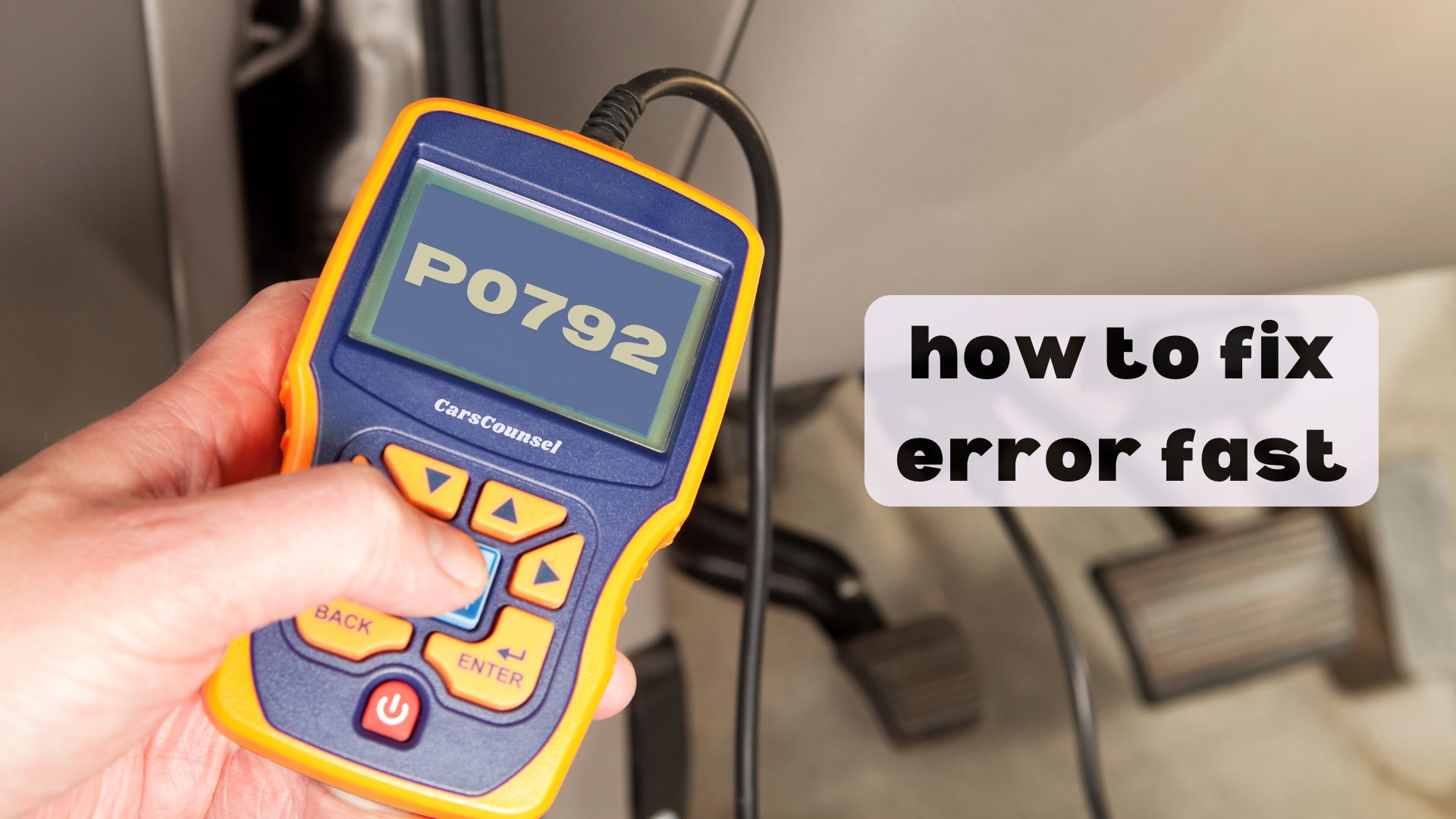Imagine your dashboard lighting up with a P0792 code. You’re probably wondering how to fix this issue quickly without breaking the bank or wasting your time.
First, you need to understand what this error code means for your car’s intermediate shaft speed sensor.
From scanning your car to checking the sensor and its wiring, there are specific steps to follow to fix this error efficiently.
How can you ensure a smooth fix and avoid future problems? Let’s go through the process together.

Quick Navigation
Key Takeaways
- Disconnect the battery and replace the faulty intermediate shaft speed sensor.
- Clean the sensor connectors to remove any dirt or corrosion.
- Inspect the wiring leading to the sensor and fix any damage.
- Use a scan tool to read transmission codes and check if the sensor data is correct.
What Is the P0792 Code?
What does the P0792 code mean for your car? It signals a problem with the intermediate shaft speed sensor circuit.
This sensor is crucial for your car’s transmission, as it keeps track of the intermediate shaft’s speed. When this sensor isn’t working right, your car’s transmission may act up, like slipping gears or shifting harshly.
The P0792 code usually means the sensor isn’t giving accurate information to the transmission control module (TCM). To figure out what’s wrong, you’ll need a scan tool to read the codes and check the sensor data, making sure both the sensor and its circuit are in good shape.
Symptoms of P0792 Code
When the P0792 code pops up, you might notice some problems with your car’s transmission. Here are the main signs to look out for:
- Rough Shifting: The car changes gears in a jerky or sudden way.
- Gears Slipping: The transmission can’t stay in gear.
- Lower Gas Mileage: You need to fill up the gas tank more often.
- Warning Lights: The transmission or check engine light turns on.
Spotting these issues early can help you fix the problem before it gets worse.
Keeping an eye on how your car shifts and how the sensors are working can ensure a smoother ride and avoid bigger problems down the road.
Common Causes
Several things can trigger the P0792 code, mostly related to problems with the transmission’s intermediate shaft speed sensor and its components.
The most common issue is a faulty sensor, which messes up how the transmission works. Damaged or corroded sensor connectors can also cause problems, leading to unpredictable behavior.
Issues with the wiring, like shorts or open circuits, often lead to similar disruptions. Additionally, a malfunctioning Transmission Control Module (TCM) may fail to read data from the sensor correctly, further affecting transmission performance.
Environmental factors like moisture and debris can also reduce the sensor’s effectiveness.
Fixing these issues step-by-step can help you clear the P0792 code and get your vehicle’s transmission working properly again.
Affected Car Models
Recognizing which car models often face the P0792 code can make it easier to fix transmission problems. Some common models that run into this issue are:
- Nissan Altima: Known for transmission slipping that triggers this code.
- Honda Civic: CVT models often report slipping gears linked to P0792.
- Mitsubishi Lancer: Frequently has transmission issues.
- Toyota Camry: Some models show this code due to transmission problems.
Diagnostic Tools
You often need a good scan tool to properly diagnose the P0792 code and check the intermediate shaft speed sensor. Start by picking a scan tool that can read transmission codes and show real-time data. Plug the scan tool into your car’s OBD-II port and run a full scan. Watch the sensor readings closely to spot any oddities or gaps in the data.
Choosing the right tool is important. Look for one that offers detailed data logging and graphing features. This helps you monitor sensor performance over time and identify problems accurately.
Make sure the scan tool can communicate well with your car’s Transmission Control Module (TCM) for a complete check-up.
Visual Inspection Tips
After you run a full scan, it’s time to take a look at the intermediate shaft speed sensor and its wiring to check for any damage or corrosion.
Here’s what to do:
- Check for visible damage: Look for cracks or breaks in the sensor and wires.
- Inspect for corrosion: Look for rust or greenish deposits on the connectors.
- Verify secure connections: Make sure all connectors are tightly connected.
- Look for frayed wires: Check for any exposed or damaged wires.
Testing Sensor Resistance
Testing Sensor Resistance
To test the sensor resistance, start by disconnecting the intermediate shaft speed sensor from its wiring harness. Then, use a multimeter to measure the resistance across the sensor terminals. Compare your readings to the manufacturer’s specifications to make sure the sensor is working correctly. Here’s a simple reference table for your resistance measurement process:
| Step | Action |
|---|---|
| 1 | Disconnect the sensor from the wiring harness |
| 2 | Set the multimeter to ohms (Ω) |
| 3 | Measure the resistance across the sensor terminals |
| 4 | Compare your readings to the manufacturer’s specs |
| 5 | Decide if the sensor is working properly |
If the readings are not within the specified range, you might need to replace the sensor. Doing this ensures your transmission works correctly and helps prevent further issues.
Checking TCM Functionality
Checking TCM Functionality
To make sure the transmission control module (TCM) is working properly, you need to verify that it communicates well with the intermediate shaft speed sensor. Here’s how you can do it:
- Run TCM diagnostics: Use a scan tool to look for any error codes and check live data from the TCM.
- Inspect wiring and connectors: Look for any damage or corrosion in the wiring and connections between the TCM and the sensor.
- Test communication: Ensure that the TCM can effectively communicate with the sensor.
- Check for transmission codes: Look for any stored codes related to transmission issues.
- Consider TCM replacement: If problems persist, you might need to replace the TCM.
Make sure you follow each step carefully to accurately identify any TCM issues.
Fixing the P0792 Code
Once you’re sure the TCM is working right, start by replacing the intermediate shaft speed sensor if it’s faulty.
First, disconnect the battery. Then, find the sensor and carefully remove it. Put in the new sensor and make sure it’s connected properly.
Next, check the sensor connector for any damage or rust. Clean it or swap it out if needed.
If the sensor and connector are okay, move on to fixing the circuit. Look at the wiring harness for any shorts or breaks. Use a multimeter to test the connections, and fix or replace any bad wires.
Preventive Maintenance
Regularly checking and taking care of your transmission system can help stop the P0792 code from coming back.
Keeping an eye on the fluid and general transmission upkeep are key steps. Start by checking your transmission fluid regularly and changing it based on the manufacturer’s guidelines. Make sure the fluid is at the right level and clean.
Also, look at the transmission’s connectors and wiring to make sure they’re in good shape.
- Check fluid levels every week
- Change transmission fluid as recommended
- Look for corrosion on connectors
- Ensure wiring is intact
More OBD-II Codes
Frequently Asked Questions
Can Driving With the P0792 Code Cause Long-Term Damage?
Driving with the P0792 code can harm your transmission over time. You might experience more slipping and irregular shifting, which can lead to expensive repairs. Fix the problem quickly to prevent major damage and keep your car running well.
How Much Does It Typically Cost to Fix the P0792 Code?
Fixing the P0792 code usually starts with a diagnostic fee of about $100 to $150. If you need to replace the sensor, it generally costs between $150 and $300. However, if there are more complicated issues like wiring problems or trouble with the transmission control module (TCM), the costs can be much higher.
Are There Any Temporary Fixes for the P0792 Code?
To temporarily fix the P0792 code, you can use diagnostic tools to reset the code and check the connections. Make sure the sensor and wiring are in good condition and clean. This might help for a short time, but you need to fix the underlying problem for a permanent solution.
Is It Safe to Drive in Limp Mode With the P0792 Code?
Driving in limp mode is like walking with a sprained ankle. You can drive short distances safely, but it’s not a long-term solution. Continuing to drive this way can cause more damage. It’s best to get your car fixed as soon as possible to ensure safety.
Can the P0792 Code Affect Other Vehicle Systems?
Yes, the P0792 code can affect other parts of the vehicle. Problems like erratic shifting and lower fuel efficiency can put extra stress on the engine. It’s important to check out the P0792 code to avoid more mechanical and electrical problems.
Conclusion
Fixing the P0792 code is like solving a puzzle, step by step.
First, use a diagnostic tool to identify the issue.
Then, check the intermediate shaft speed sensor and its wiring for any problems.
Replace any faulty parts you find.
Also, inspect the wiring harness for any shorts or breaks.
Once you’ve done all that, clear the code and see if it comes back.
By following these steps, you’ll keep your vehicle running smoothly.

